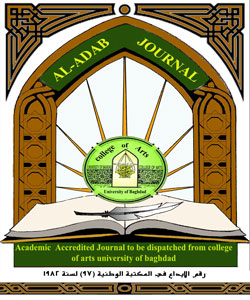جذر(فَعْلَلَ) المضاعف واشتقاقاته في القرآن الكريم
دراسة أُسلوبية
DOI:
https://doi.org/10.31973/aj.v0i133.892الكلمات المفتاحية:
القرآن الكريم، فَعْلَلَ، الأسلوب، المستوى الصوتي، المستوى الصرفيالملخص
ينهض هذا البحث بالتحليل الأُسلوبي للكلمات التي جاءت في القرآن الكريم على جذر فَعْلَلَ، ويتناول المستويات الأُسلوبية من الصوت والصرف والدلالة لبيان تأثير حضور هذه الكلمات وأثرها في انبثاق الدلالات السياقية للآيات وتأثيرها في المتلقي، ويحاول تأصيل الوضع للفعل الرباعي في اللغة العربية بالأدلة والبراهين والأمثلة.
التنزيلات
المراجع
- Ibn Manzur, Jamal al-Din Muhammad (711 AH) (2003): Lisan Al-Arab, Dar Al-Hadith, Cairo.
- Anis, Ibrahim (1975): Linguistic Voices, The Anglo Egyptian Library, Fifth Edition, Egypt.
- Al-Tabrizi, Abi Zakaria Yahya bin Ali bin Muhammad bin Hassan known as Al-Khatib (502 AH) (2004): Summary in the Syntax of the Qur’an, an investigation by Dr. Yahya Murad, Dar Al-Hadith, Cairo.
- Al-Gohary, Imam Ismail bin Hammad (2008): Al-Sahah Dictionary, taken care of by: Khalil Mamoun Shiha, Dar Al-Maarefah, Third Edition, Beirut - Lebanon.
- Al-Hamlani, Ahmed bin Muhammad bin Ahmed (without history): Shaza Al-Arf in the art of exchange, achieved by Muhammad bin Farid, the endowment library, Cairo – Egypt.
- Al-Khafaji, Toman Ghazi (2012): Stylistic Structures in Surat Ash-Shu`ara ', Dar Tammuz, First Edition, Damascus.
- Al-Dahdah, Ambassador Antoine (2004): Conjugation of Arabic Verbs. A Lexicon of Conjugating Arabic Verbs, revised by: Dr. George Mitri Abdel-Messih, Lebanon Publishers, Fifth Edition.
- Al-Ragheb Al-Isfahani (425 AH) (2000): Vocabulary of the words of the Qur’an, by: Safwan Adnan Daoudi, Dar Al-Qalam, first edition, Damascus, Dar Shamiya, Beirut.
- Al-Zamakhshari, Abu al-Qasim Jarallah Mahmoud bin Omar (538 AH) (2005): Interpretation of the Scout, commented on by Khalil Mamoun Shiha, Dar Al-Maarefah, Second Edition, Beirut – Lebanon.
- Al-Samurai, Dr. Fadel Saleh (1981): The meanings of buildings in Arabic, University of Baghdad, first edition, Baghdad.
- Al-Samurai, Dr. Fadel Saleh (2003): The meanings of grammar, Dar al-Fikr, second edition, Oman
- Al-Samurai, Dr. Fadel Saleh (2006): Quranic Expression, Dar Ammar, Fourth Edition, Oman.
- Suleiman, Aisha Muhammad (2003): morphological buildings in the civil fence, semantic linguistic study, supervision: Prof. Dr. Ahmed Hassan Hamid, An-Najah National University, College of Graduate Studies.
- Shaarawi, Sheikh Muhammad Metwally (1988): The Miracle of the Qur’an, Muslim Library Publications, Mosul.
- Alsiygh, Dr. Abdul Aziz Saeed (2000): The phonetic term in phoneme, Dar Al-Fikr, first edition, Damascus.
- Azeemah, Muhammad Abdul-Khaliq (2004): Studies of the style of the Noble Qur’an, Dar Al-Hadith, Cairo, Volume V.
- Omar, Ahmed Mukhtar (2006): semantics, book world, sixth edition, Beirut.
- Fathi, Ibrahim (1986): A Glossary of Literary Terms, The Arab Association for United Publishers, Dar Ibn Rushd, Beirut - Lebanon.
- Al-Fartousi, Dr. Salah Mahdi, and Shallash, Dr. Hashem Taha (2013): polite in the science of drainage, Beirut Modern Printing Press, first edition, Beirut – Lebanon.
- Alfiruzabady, Muhyiddin Muhammed bin Yaqoub (2008): A dictionary of the surrounding dictionary, arranged and documented: Khalil Mamoun Shiha, Dar Al-Maarefa, second edition, Beirut – Lebanon.
- Qaitoun, Qwaider (2015): The psychological miracle in the Quranic discourse, PhD thesis, supervision: Dr. Aziz Akashy, University of Constantine, Faculty of Arts and Languages.
- Karim, Fawzi (2000): The Emperor's Clothes (Poetry and Mirrors of Deceptive Modernity), Dar Al-Mada for Culture and Publishing, First Edition, Baghdad.
- Mazari, Scharf (2009): Aesthetic reception in the Holy Qur’an, Literary rhythm, the miraculous rhythm as a model, Arab Writers Union Press, Damascus, series of studies (15).
- Mustafa, Ibrahim and others (1989): The Intermediate Dictionary, The Arabic Language Academy, Dar Al-Dawa, Turkey – Istanbul.
التنزيلات
منشور
إصدار
القسم
الرخصة
:حقوق الطبع والنشر والترخيص
بالنسبة لجميع البحوث المنشورة في مجلة الآداب، يحتفظ الباحثون بحقوق النشر. يتم ترخيص البحوث بموجب ترخيص Creative Commons CC BY 4.0 المفتوح ، مما يعني أنه يجوز لأي شخص تنزيل البحث وقراءته مجانًا. بالإضافة إلى ذلك ، يجوز إعادة استخدام البحث واقتباسه شريطة أن يتم الاستشهاد المصدر المنشور الأصلي. تتيح هذه الشروط الاستخدام الأقصى لعمل الباحث وعرضه.
:إعادة إنتاج البحوث المنشورة من الناشرين الآخرين
من الضروري للغاية أن يحصل الباحثون على إذن لإعادة إنتاج أي بحث منشورة (أشكال أو مخططات أو جداول أو أي مقتطفات من نص) لا يدخل في نطاق الملكية العامة أو لا يملكون حقوق نشرها. يجب أن يطلب الباحثون إذنًا من مؤلف حقوق النشر (عادة ما يكون الناشر).
يطلب الإذن في الحالات التالية:
بحوثك الخاصة المنشورة من قِبل ناشرين آخرين ولم تحتفظ بحقوق النشر الخاصة بها.
مقتطفات كبيرة من بحوث أي شخص أو سلسلة من البحوث المنشورة.
استخدم الجداول والرسوم البيانية والمخططات والمخططات والأعمال الفنية إذا لم يتم التعديل عليها.
الصور الفوتوغرافية التي لا تملك حقوق لنشرها.
لا يطلب الإذن في الحالات التالية:
إعادة بناء الجدول الخاص بك مع البيانات المنشورة بالفعل في مكان آخر. يرجى ملاحظة أنه في هذه الحالة يجب عليك ذكر مصدر البيانات في شكل "بيانات من ..." أو "مقتبس من ...".
تعتبر عروض الأسعار القصيرة معقولة الاستخدام العادل ، وبالتالي لا تتطلب إذنًا.
الرسوم البيانية ، الرسوم البيانية ، المخططات ، الأعمال الفنية التي أعاد الباحث رسمها بالكامل والتي تم تغييرها بشكل ملحوظ إلى درجة لا تتطلب الاعتراف.
الحصول على إذن
لتجنب التأخير غير الضروري في عملية النشر ، يجب أن تبدأ في الحصول على أذونات في أقرب وقت ممكن. لا يمكن لمجلة الآداب نشر بحث مقتبس من منشورات أخرى دون إذن.
قد يمنحك مالك حقوق الطبع والنشر تعليمات بشأن شكل الإقرار الواجب اتباعه لتوثيق عمله ؛ بخلاف ذلك ، اتبع النمط: "مستنسخ بإذن من [المؤلف] ، [كتاب / المجلة] ؛ نشره [الناشر] ، [السنة]." في نهاية شرح الجدول ، الشكل أو المخطط.
.jpg)























